Viscoelastic Heart Patch Treats Myocardial Infarction
|
By HospiMedica International staff writers Posted on 01 May 2019 |
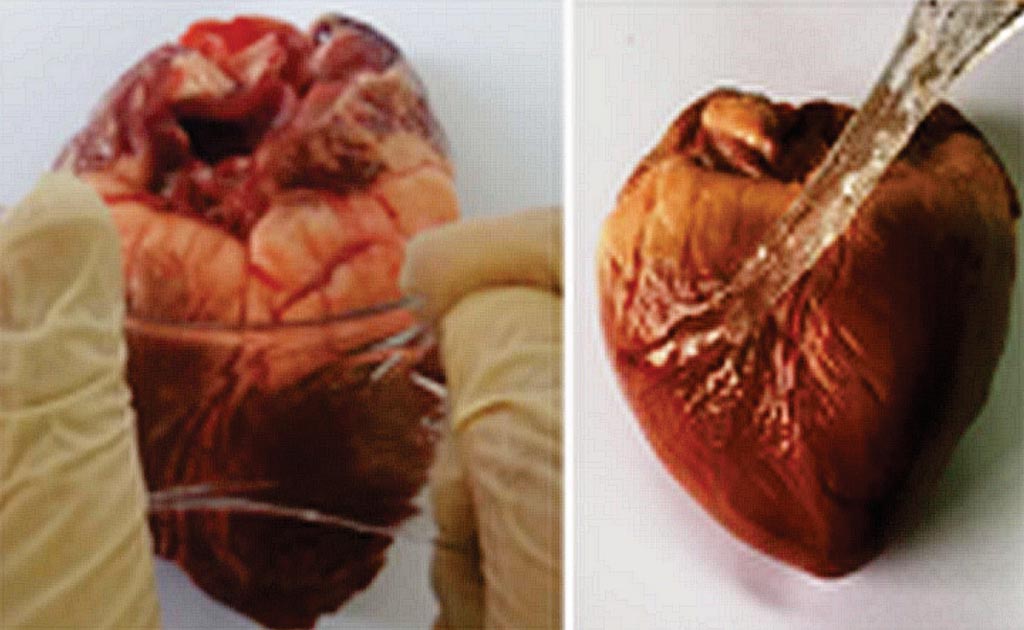
Image: The GPAP attaches to the epicardium, supporting the heart (Photo courtesy of Brown University).
An adhesive epicardial patch could increase the mechanical integrity of damaged left ventricular tissues following a heart attack, claims a new study.
Developed by researchers at Brown University (Providence, RI, USA), Fudan University (Shanghai, China), Soochow University (Suzhou, China), and other institutions, the ionically crosslinked transparent gel-point adhesive patch (GPAP) is a viscoelastic material that combines both fluid and solid properties. The fluid properties are retained up to a certain amount of stress, at which point the material solidifies and turns stiffer, which can accommodate the cyclic deformation of the myocardium and left ventricular remodeling following acute and subacute myocardial infarction (MI).
To determine the optimum mechanical properties of the GPAP, the researchers developed a computer model of the beating heart of a rat, which captured the mechanical dynamics of both the heart itself and the patch when fixed to the heart's exterior. After analyzing simulated modelling data, the researchers developed a GPAP with a low dynamic modulus that provided nearly optimal mechanical support to the remaining cardiomyocytes. The patch also outperformed other patches whose mechanical properties had been selected on an ad hoc basis. The study was published on April 15, 2019, in Nature Biomedical Engineering.
“Part of the reason that it's hard for the heart to recover after a heart attack is that it has to keep pumping. The idea here is to provide mechanical support for damaged tissue, which hopefully gives it a chance to heal,” said senior author professor of engineering Huajian Gao, PhD, of Brown University. “It remains to be seen if it will work in humans, but it's very promising. We don't see any reason right now that it wouldn't work.”
Cardiomyocytes carry out the contractile function of the heart, and the majority of them are terminally differentiated post-mitotic cells that exhibit very limited regenerative potential, and as a result the heart has insufficient regenerative capacity after injury or in diseased states, such as after a MI.
Related Links:
Brown University
Fudan University
Soochow University
Developed by researchers at Brown University (Providence, RI, USA), Fudan University (Shanghai, China), Soochow University (Suzhou, China), and other institutions, the ionically crosslinked transparent gel-point adhesive patch (GPAP) is a viscoelastic material that combines both fluid and solid properties. The fluid properties are retained up to a certain amount of stress, at which point the material solidifies and turns stiffer, which can accommodate the cyclic deformation of the myocardium and left ventricular remodeling following acute and subacute myocardial infarction (MI).
To determine the optimum mechanical properties of the GPAP, the researchers developed a computer model of the beating heart of a rat, which captured the mechanical dynamics of both the heart itself and the patch when fixed to the heart's exterior. After analyzing simulated modelling data, the researchers developed a GPAP with a low dynamic modulus that provided nearly optimal mechanical support to the remaining cardiomyocytes. The patch also outperformed other patches whose mechanical properties had been selected on an ad hoc basis. The study was published on April 15, 2019, in Nature Biomedical Engineering.
“Part of the reason that it's hard for the heart to recover after a heart attack is that it has to keep pumping. The idea here is to provide mechanical support for damaged tissue, which hopefully gives it a chance to heal,” said senior author professor of engineering Huajian Gao, PhD, of Brown University. “It remains to be seen if it will work in humans, but it's very promising. We don't see any reason right now that it wouldn't work.”
Cardiomyocytes carry out the contractile function of the heart, and the majority of them are terminally differentiated post-mitotic cells that exhibit very limited regenerative potential, and as a result the heart has insufficient regenerative capacity after injury or in diseased states, such as after a MI.
Related Links:
Brown University
Fudan University
Soochow University
Latest Critical Care News
- AI Tool Reduces Serious Complications and Readmissions After Colorectal Cancer Surgery
- Time-Released Gel Eliminates Residual Brain Tumor Cells Post Resection
- Handheld Sensor Could Replace Blood Tests for Health Monitoring
- 3D-Printed Carbon Nanotube Sensors to Enable Smart Health Monitoring
- Wearable ‘Microscope in a Bandage’ Fastens Wound Healing
- Virus Cocktail to Combat Superbugs Offers New Precision Medicine Approach for Hospitals Battling AMR
- Smart Biosensors Could Be Game-Changer for Wearable Health Tech
- Brainwave Test Detects Memory Decline Years Before Alzheimer’s Diagnosis
- Low-Cost Medical Device Stops Postpartum Hemorrhages
- Non-Invasive Wearable Sensor Detects Sweat Biomarker in Low-Perspiration Conditions
- New Autoinjector Could Transform Trauma Care in Severe Bleeding Emergencies
- Portable Light-Based Brain Monitor Improves Dementia Diagnosis
- New Ultrasound Technique Enables Safer Vein Access in Critically Ill Patient
- CVD Risk Prediction Tool Could Guide Statin Therapy
- Wearables Could Revolutionize Pregnancy Monitoring and Detect Abnormalities
- AI Model Identifies AF Patients Requiring Blood Thinners to Prevent Stroke
Channels
Surgical Techniques
view channel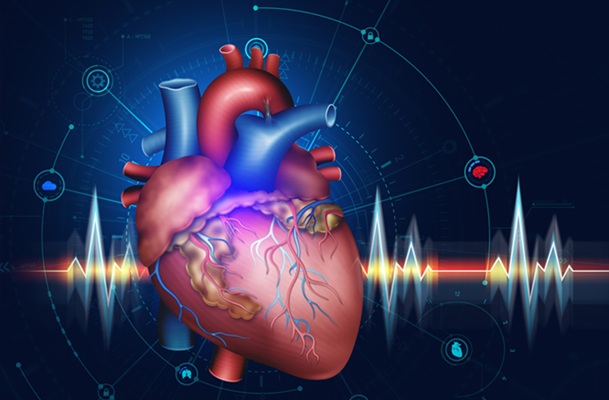
World's First Transcatheter Smart Implant Monitors and Treats Congestion in Heart Failure
Heart failure is one of the leading causes of hospitalization worldwide, with millions of patients requiring ongoing treatment to manage congestion. Current therapies often involve tracking remotely measured... Read more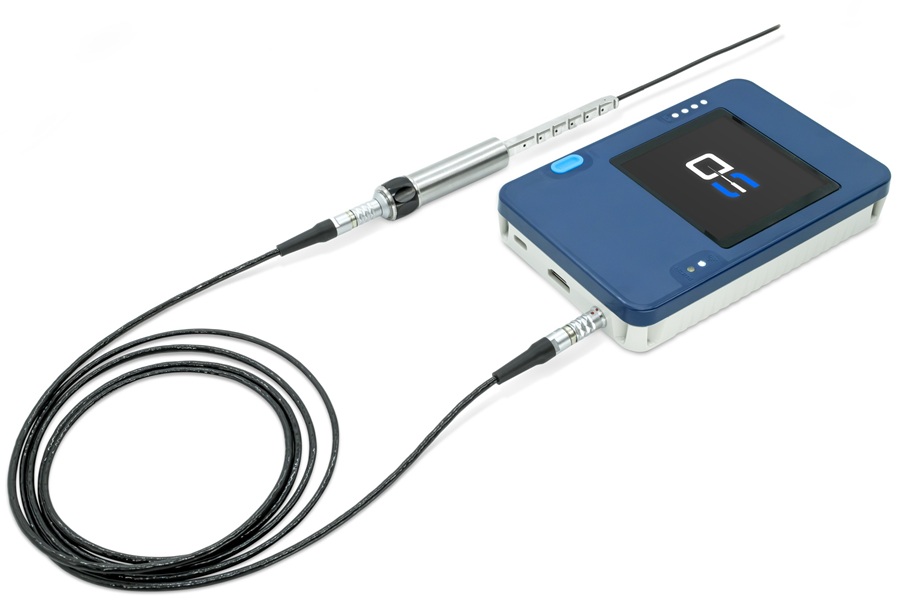
Hybrid Endoscope Marks Breakthrough in Surgical Visualization
For more than three decades, surgical endoscopy has depended on either rigid or flexible scopes, each with major drawbacks. Rigid scopes offer precision but limit maneuverability, while flexible scopes... Read more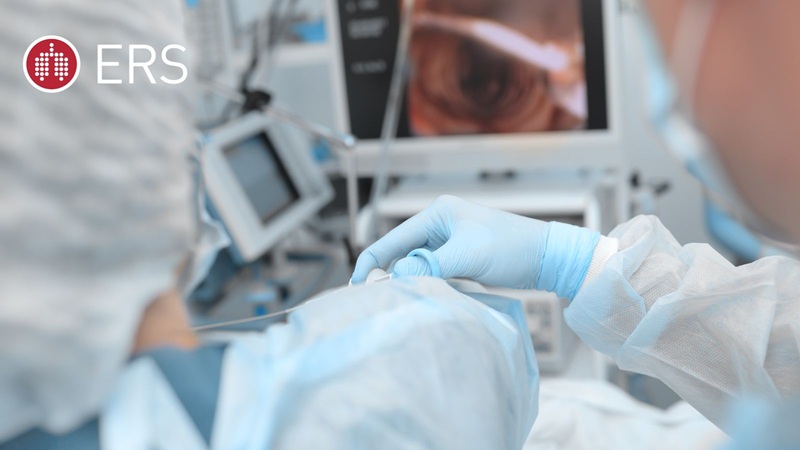
Robot-Assisted Bronchoscope Diagnoses Tiniest and Hardest to Reach Lung Tumors
Lung cancer is one of the deadliest cancers in Europe, killing around a quarter of a million people annually. Survival rates are much higher when tumors are diagnosed at an early stage, but the tiniest... Read more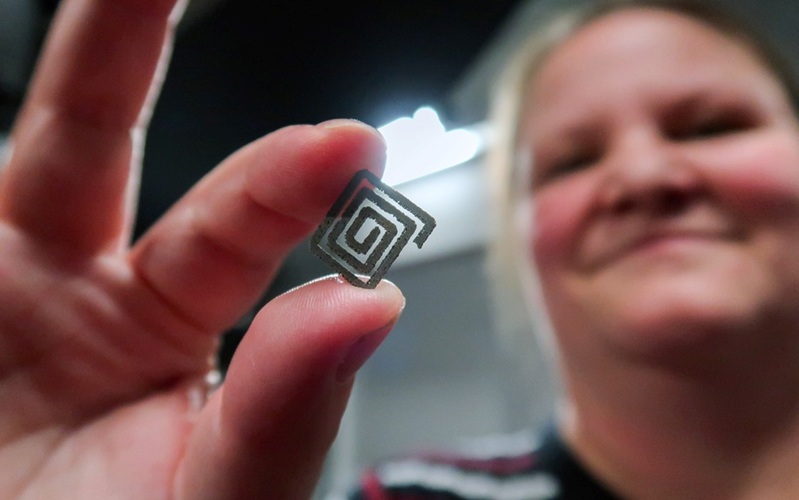
Diamond-Titanium Device Paves Way for Smart Implants that Warn of Disease Progression
Medical implants such as stents, prosthetics, and drug-release systems often rely on batteries that take up space, wear out, and eventually require replacement surgery. These limitations increase risks... Read morePatient Care
view channel
Revolutionary Automatic IV-Line Flushing Device to Enhance Infusion Care
More than 80% of in-hospital patients receive intravenous (IV) therapy. Every dose of IV medicine delivered in a small volume (<250 mL) infusion bag should be followed by subsequent flushing to ensure... Read more
VR Training Tool Combats Contamination of Portable Medical Equipment
Healthcare-associated infections (HAIs) impact one in every 31 patients, cause nearly 100,000 deaths each year, and cost USD 28.4 billion in direct medical expenses. Notably, up to 75% of these infections... Read more
Portable Biosensor Platform to Reduce Hospital-Acquired Infections
Approximately 4 million patients in the European Union acquire healthcare-associated infections (HAIs) or nosocomial infections each year, with around 37,000 deaths directly resulting from these infections,... Read moreFirst-Of-Its-Kind Portable Germicidal Light Technology Disinfects High-Touch Clinical Surfaces in Seconds
Reducing healthcare-acquired infections (HAIs) remains a pressing issue within global healthcare systems. In the United States alone, 1.7 million patients contract HAIs annually, leading to approximately... Read moreHealth IT
view channel
Printable Molecule-Selective Nanoparticles Enable Mass Production of Wearable Biosensors
The future of medicine is likely to focus on the personalization of healthcare—understanding exactly what an individual requires and delivering the appropriate combination of nutrients, metabolites, and... Read moreBusiness
view channel
Philips and Masimo Partner to Advance Patient Monitoring Measurement Technologies
Royal Philips (Amsterdam, Netherlands) and Masimo (Irvine, California, USA) have renewed their multi-year strategic collaboration, combining Philips’ expertise in patient monitoring with Masimo’s noninvasive... Read more
B. Braun Acquires Digital Microsurgery Company True Digital Surgery
The high-end microsurgery market in neurosurgery, spine, and ENT is undergoing a significant transformation. Traditional analog microscopes are giving way to digital exoscopes, which provide improved visualization,... Read more
CMEF 2025 to Promote Holistic and High-Quality Development of Medical and Health Industry
The 92nd China International Medical Equipment Fair (CMEF 2025) Autumn Exhibition is scheduled to be held from September 26 to 29 at the China Import and Export Fair Complex (Canton Fair Complex) in Guangzhou.... Read more












